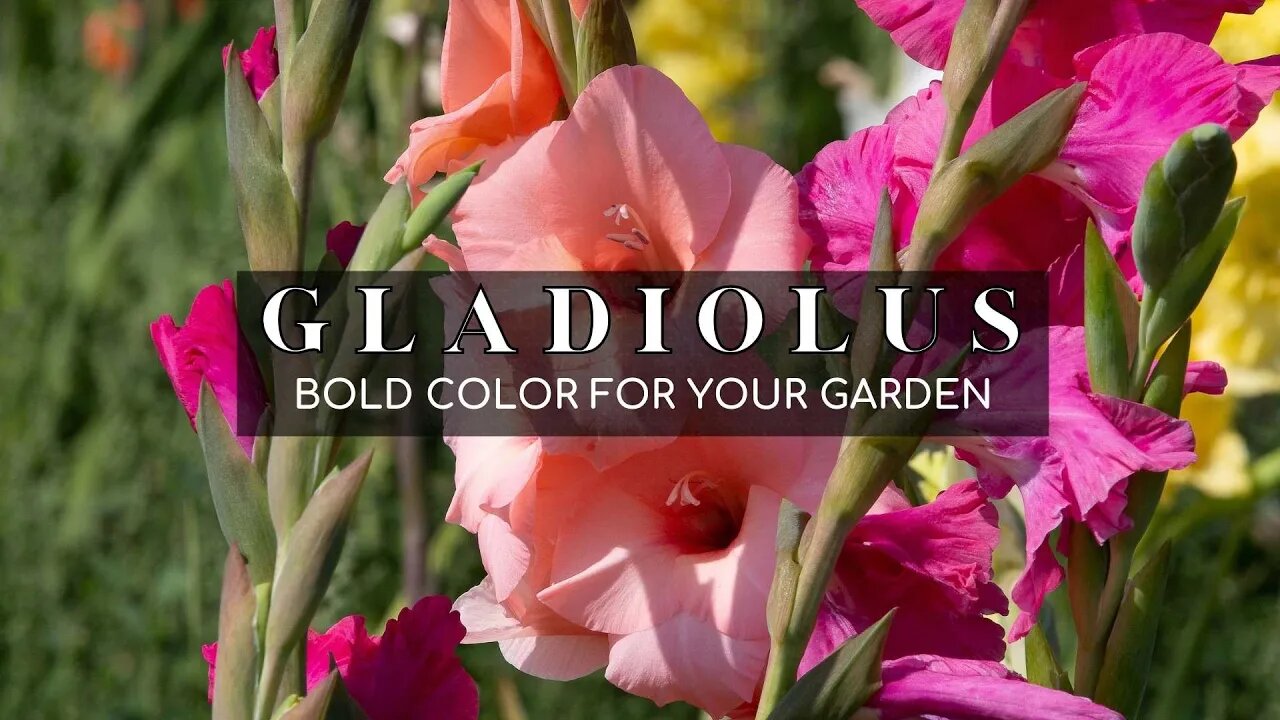Premium Only Content

GLADIOLUS: Sword Lily Adds Vertical Interest and Bold Color to Your Garden.
Gladiolus: Add Vertical Interest and Bold Color to Your Garden.
Gladiolus, also known as sword lily, is popular among gardeners for its striking, colorful blooms and tall, elegant growth habit. These eye-catching plants can make a bold statement in any garden setting. In this article, we will explore the characteristics of gladiolus, including its appearance, growing zones, planting, care, and maintenance.
Colors and Appearance.
Gladiolus comes in various colors, including red, pink, purple, orange, yellow, cream, and white. The flowers are funnel-shaped and arranged along a tall, upright spike or inflorescence, with sword-like leaves emanating from the base of the plant. Gladiolus can grow anywhere from 2 to 6 feet tall, depending on the variety.
While gladiolus is primarily pollinated by wind, it can also attract various insects, such as bees and butterflies, due to its vivid colors and sweet nectar.
Growing Zones and Environmental Conditions.
Gladiolus is native to Africa and thrives in USDA plant hardiness zones 7 to 10. These plants prefer well-draining soil with a pH level of 6.0 to 6.5. Gladiolus requires full sun, with at least 6 hours of direct sunlight daily, for optimal growth and flowering.
Latin Names.
The Gladiolus genus comprises more than 250 species and numerous cultivars, with some of the most popular being the following:
Gladiolus x hortulanus, Garden Gladiolus.
Gladiolus dalenii, Parrot Gladiolus.
Gladiolus nanus, Dwarf Gladiolus.
Gladiolus callianthus, Peacock Orchid.
When to Plant Gladiolus.
Gladiolus comes from corms, underground, bulb-like structures that store nutrients and energy for the plant. The roots, shoots, and leaves are the base from which they grow. While similar to bulbs, they have a firm, starchy interior, and a papery outer tunic. On the other hand, bulbs have fleshy scales surrounding a central bud.
The best time to plant gladiolus corms is in the spring after the danger of frost has passed and the soil has warmed.
Planting, Care, and Maintenance.
Prepare the planting site by loosening the soil to a depth of 12 inches and incorporating compost or other organic matter to improve drainage and fertility.
Plant the corms 4 to 6 inches deep and 6 to 8 inches apart, with the pointed side facing upward.
Water the corms thoroughly after planting and maintain consistent moisture throughout the growing season. Avoid overwatering, as this can lead to rot.
Apply a layer of mulch around the plants to help conserve moisture, suppress weeds, and regulate soil temperature.
Stake tall gladiolus varieties to provide support and prevent the flower spikes from toppling over.
Remove spent flowers to maintain a neat appearance and prevent the plant from expending energy on seed production.
Fertilize gladiolus with a balanced, slow-release fertilizer when the foliage emerges and again when the flower spikes begin to show color.
In colder climates, zones 6 and below, lift the corms in the fall after the foliage has yellowed. Clean and store them in a cool, dry place for the winter before replanting in the spring.
Gladiolus adds dramatic vertical interest and a splash of bold color to any garden, making it an eye-catching choice for gardeners seeking to create a stunning display. By following the planting and care guidelines outlined, you can enjoy the beautiful, statuesque blooms of gladiolus in your garden for years to come. These spectacular plants are perfect for creating a focal point in your garden beds or borders, and their cut flowers make an excellent addition to floral arrangements. With proper care and attention, gladiolus will reward you with a breathtaking display that elevates your garden to new heights.
Connect with us
Facebook: https://www.facebook.com/TayloesLawnCare
Web: https://www.tayloeslawncare.com
MeWe: https://mewe.com/p/diyhomegarden
Image and music licensed via Canva Pro
-
 0:51
0:51
Garden Revelations
1 year agoHYACINTH: A breathtaking early spring bulb flower to plant in the fall for early spring pollinators
113 -
 1:42:21
1:42:21
The Quartering
11 hours agoTrump To INVADE Mexico, Take Back Panama Canal Too! NYC Human Torch & Matt Gaetz Report Drops!
109K92 -
 2:23:15
2:23:15
Nerdrotic
11 hours ago $0.77 earnedA Very Merry Christmas | FNT Square Up - Nerdrotic Nooner 453
86.9K12 -
 1:14:05
1:14:05
Tucker Carlson
11 hours ago“I’ll Win With or Without You,” Teamsters Union President Reveals Kamala Harris’s Famous Last Words
173K338 -
 1:58:31
1:58:31
The Dilley Show
11 hours ago $1.42 earnedTrump Conquering Western Hemisphere? w/Author Brenden Dilley 12/23/2024
137K39 -
 1:09:59
1:09:59
Geeks + Gamers
12 hours agoSonic 3 DESTROYS Mufasa And Disney, Naughty Dog Actress SLAMS Gamers Over Intergalactic
97.2K21 -
 51:59
51:59
The Dan Bongino Show
13 hours agoDemocrat Donor Admits The Scary Truth (Ep. 2393) - 12/23/2024
871K2.86K -
 2:32:15
2:32:15
Matt Kohrs
1 day agoRumble CEO Chris Pavlovski Talks $775M Tether Partnership || The MK Show
128K31 -
 28:23
28:23
Dave Portnoy
1 day agoDavey Day Trader Presented by Kraken - December 23, 2024
160K43 -
 59:29
59:29
BonginoReport
15 hours agoTrump, Murder Plots, and the Christmas Miracle: Evita + Jack Posobiec (Ep.110) - 12/23/2024
165K140